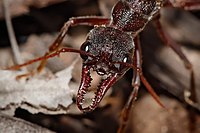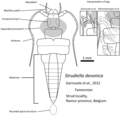Portal:Insects
The Insects Portal


Insects (from Latin insectum) are hexapod invertebrates of the class Insecta. They are the largest group within the arthropod phylum. Insects have a chitinous exoskeleton, a three-part body (head, thorax and abdomen), three pairs of jointed legs, compound eyes, and a pair of antennae. Insects are the most diverse group of animals, with more than a million described species; they represent more than half of all animal species. (Full article...)
Selected article -
The green-head ant (Rhytidoponera metallica) is a species of ant that is endemic to Australia. It was described by British entomologist Frederick Smith in 1858 as a member of the genus Rhytidoponera in the subfamily Ectatomminae. These ants measure between 5 and 7 mm (0.20 and 0.28 in). The queens and workers look similar, differing only in size, with the males being the smallest. They are well known for their distinctive metallic appearance, which varies from green to purple or even reddish-violet. Among the most widespread of all insects in Australia, green-head ants are found in almost every Australian state, but are absent in Tasmania. They have also been introduced in New Zealand, where several populations have been established.
This species lives in many habitats, including deserts, forests, woodland and urban areas. They nest underground below logs, stones, twigs, and shrubs, or in decayed wooden stumps, and are sometimes found living in termite mounds. They are among the first insects to be found in burnt-off areas after the embers have stopped smouldering. Rain presents no threat to colonies as long as it is a light shower in continuous sunshine. The green-head ant is diurnal, active throughout the day, preying on arthropods and small insects or collecting sweet substances such as honeydew from sap-sucking insects. They play an important role in seed dispersal, scattering and consuming seeds from a variety of species. Predators include the short-beaked echidna (Tachyglossus aculeatus) and a number of bird species. (Full article...)Did you know -
- ... that the seeds of the European sedge Carex pilulifera may be dispersed by the ant Myrmica ruginodis?
- ... that the oldest known member of the mayfly family Neoephemeridae is the Eocene species Neoephemera antiqua?
- ... that Sphecius grandis, the Western cicada killer wasp, paralyzes cicadas for its offspring to eat after hatching?
- ... that the extinct griffenfly genus Bohemiatupus inhabited peat-mires?
- ... that the extinct hangingfly genera Formosibittacus, Jurahylobittacus, and Mongolbittacus are only known from the Middle Jurassic of China?
List articles
Related portals
General images -
Selected image -

Abantiades latipennis (Lepidoptera: Hepialidae) is one of fourteen species in the Australian genus Abantiades. It thrives in regrowth forests that were previously clearfelled; the phytophagous larvae of A. latipennis feed primarily on the root systems of two species of tree, Eucalyptus obliqua (messmate stringybark) and Eucalyptus regnans (mountain ash).
WikiProjects

Main WikiProject:
Related projects:
- WikiProject Arthropods
- WikiProject Spiders
- WikiProject Animals
- WikiProject Tree of Life
- WikiProject Biology
Daughter projects:
Tasks
 |
Here are some tasks awaiting attention:
|
Associated Wikimedia
The following Wikimedia Foundation sister projects provide more on this subject:
-
Commons
Free media repository -
Wikibooks
Free textbooks and manuals -
Wikidata
Free knowledge base -
Wikinews
Free-content news -
Wikiquote
Collection of quotations -
Wikisource
Free-content library -
Wikiversity
Free learning tools -
Wiktionary
Dictionary and thesaurus




















































